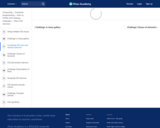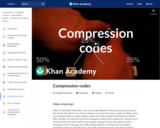
Combining CSS class and element selectors.
- Subject:
- Applied Science
- Computer Science
- Material Type:
- Interactive
- Lesson
- Provider:
- Khan Academy
- Provider Set:
- Khan Academy
- Author:
- Pamela Fox
- Date Added:
- 07/11/2021

Combining CSS class and element selectors.

How to combine multiple joins

With so much information at our fingertips, students learn what it means to "give credit" when using content they find online. Taking on the role of a detective, students learn why it's important to give credit and the right ways to do it when they use words, images, or ideas that belong to others.
In this introduction to plagiarism and good digital citizenship, second graders are encouraged to give credit to people whose work they reference when doing projects.
Although written for second grade, this lesson could be easily adapted to upper primary and even middle school levels.

This course will explore the state of the art in common sense knowledge, and class projects will design and build interfaces that can exploit this knowledge to make more usable and helpful interfaces.
This year’s theme will be about how common sense knowledge differs in different languages and cultures, and how machine understanding of this knowledge can help increase communication between people, and between people and machines.

This course will explore the state of the art in common sense knowledge, and class projects will design and build interfaces that can exploit this knowledge to make more usable and helpful interfaces.
Course requirements will consist of critiques of class readings (about 2 papers/week), and a final project (paper or computer implementation project). Grades will be based primarily on the projects, as well as a small component for class and online participation

Communicating With Data has a distinctive structure and content, combining fundamental quantitative techniques of using data to make informed management decisions with illustrations of how real decision makers, even highly trained professionals, fall prey to errors and biases in their understanding. We present the fundamental concepts underlying the quantitative techniques as a way of thinking, not just a way of calculating, in order to enhance decision-making skills. Rather than survey all of the techniques of management science, we stress those fundamental concepts and tools that we believe are most important for the practical analysis of management decisions, presenting the material as much as possible in the context of realistic business situations from a variety of settings. Exercises and examples drawn from marketing, finance, operations management, strategy, and other management functions.

This course presents a top-down approach to communications system design. The course will cover communication theory, algorithms and implementation architectures for essential blocks in modern physical-layer communication systems (coders and decoders, filters, multi-tone modulation, synchronization sub-systems). The course is hands-on, with a project component serving as a vehicle for study of different communication techniques, architectures and implementations. This year, the project is focused on WLAN transceivers. At the end of the course, students will have gone through the complete WLAN System-On-a-Chip design process, from communication theory, through algorithm and architecture all the way to the synthesized standard-cell RTL chip representation.

This course will cover fundamentals of digital communications and networking. We will study the basics of information theory, sampling and quantization, coding, modulation, signal detection and system performance in the presence of noise. The study of data networking will include multiple access, reliable packet transmission, routing and protocols of the internet. The concepts taught in class will be discussed in the context of aerospace communication systems: aircraft communications, satellite communications, and deep space communications.

This genomics education lesson plan was formulated and tested on some year 6 students with the help of their teacher Michelle Pardini at the Hong Kong ICS School. Using the example of the ongoing citizen science Bahinia Genome project from Hong Kong it hopes to serve as a model to inspire and inform other national genome projects, and aid the development of crucial genomic literacy and skills across the globe. Inspiring and training a new generation of scientists to use these tools to tackle the biggest threats to mankind: climate change, disease, and food security. It is released under a CC-BY SA 4.0 license, and utilised the following slide deck and final quiz. Promoting open science, all of the data and resources produced from the project is immediately put into the public domain. Please feel free to utilise, adapt and build upon any of these as you wish. The open licence makes these open education resources usable just with attribution and posting of modified resources under a similar manner. Contact BauhiniaGenome if you have any questions or feedback.Bauhinia Genome overviewFor a slidedeck for the lesson plan laid out here you can use the set in slideshare here.

This course is offered to graduates and is a project-oriented course to teach new methodologies for designing multi-million-gate CMOS VLSI chips using high-level synthesis tools in conjunction with standard commercial EDA tools. The emphasis is on modular and robust designs, reusable modules, correctness by construction, architectural exploration, and meeting the area, timing, and power constraints within standard cell and FPGA frameworks.

This lesson is an extension of LA lessons teaching compound words. Once students are introduced to the concept of compound words, they will listen to a picture book and see if they can identify compound words from the book. Take time while reading to discuss the words. You may consider making a chart as you read. Be sure students understand that in a compound word, each word has a meaning, and when put together, the new word has a different meaning.

What is the limit of compression? Created by Brit Cruise.

6.844 is a graduate introduction to programming theory, logic of programming, and computability, with the programming language Scheme used to crystallize computability constructions and as an object of study itself. Topics covered include: programming and computability theory based on a term-rewriting, “substitution” model of computation by Scheme programs with side-effects; computation as algebraic manipulation: Scheme evaluation as algebraic manipulation and term rewriting theory; paradoxes from self-application and introduction to formal programming semantics; undecidability of the Halting Problem for Scheme; properties of recursively enumerable sets, leading to Incompleteness Theorems for Scheme equivalences; logic for program specification and verification; and Hilbert’s Tenth Problem.

This course introduces architecture of digital systems, emphasizing structural principles common to a wide range of technologies. It covers the topics including multilevel implementation strategies, definition of new primitives (e.g., gates, instructions, procedures, processes) and their mechanization using lower-level elements. It also includes analysis of potential concurrency, precedence constraints and performance measures, pipelined and multidimensional systems, instruction set design issues and architectural support for contemporary software structures.

6.004 offers an introduction to the engineering of digital systems. Starting with MOS transistors, the course develops a series of building blocks — logic gates, combinational and sequential circuits, finite-state machines, computers and finally complete systems. Both hardware and software mechanisms are explored through a series of design examples.
6.004 is required material for any EECS undergraduate who wants to understand (and ultimately design) digital systems. A good grasp of the material is essential for later courses in digital design, computer architecture and systems. The problem sets and lab exercises are intended to give students “hands-on” experience in designing digital systems; each student completes a gate-level design for a reduced instruction set computer (RISC) processor during the semester.

A computational camera attempts to digitally capture the essence of visual information by exploiting the synergistic combination of task-specific optics, illumination, sensors and processing. In this course we will study this emerging multi-disciplinary field at the intersection of signal processing, applied optics, computer graphics and vision, electronics, art, and online sharing through social networks. If novel cameras can be designed to sample light in radically new ways, then rich and useful forms of visual information may be recorded — beyond those present in traditional photographs. Furthermore, if computational process can be made aware of these novel imaging models, them the scene can be analyzed in higher dimensions and novel aesthetic renderings of the visual information can be synthesized.
We will discuss and play with thermal cameras, multi-spectral cameras, high-speed, and 3D range-sensing cameras and camera arrays. We will learn about opportunities in scientific and medical imaging, mobile-phone based photography, camera for HCI and sensors mimicking animal eyes. We will learn about the complete camera pipeline. In several hands-on projects we will build physical imaging prototypes and understand how each stage of the imaging process can be manipulated.

This course is an introduction to computational theories of human cognition. Drawing on formal models from classic and contemporary artificial intelligence, students will explore fundamental issues in human knowledge representation, inductive learning and reasoning. What are the forms that our knowledge of the world takes? What are the inductive principles that allow us to acquire new knowledge from the interaction of prior knowledge with observed data? What kinds of data must be available to human learners, and what kinds of innate knowledge (if any) must they have?

An introduction to computational theories of human cognition. Emphasizes questions of inductive learning and inference, and the representation of knowledge. Project required for graduate credit. This class is suitable for intermediate to advanced undergraduates or graduate students specializing in cognitive science, artificial intelligence, and related fields.

This class introduces design as a computational enterprise in which rules are developed to compose and describe architectural and other designs. The class covers topics such as shapes, shape arithmetic, symmetry, spatial relations, shape computations, and shape grammars. It focuses on the application of shape grammars in creative design, and teaches shape grammar fundamentals through in-class, hands-on exercises with abstract shape grammars. The class discusses issues related to practical applications of shape grammars.

Topics in surface modeling: b-splines, non-uniform rational b-splines, physically based deformable surfaces, sweeps and generalized cylinders, offsets, blending and filleting surfaces. Non-linear solvers and intersection problems. Solid modeling: constructive solid geometry, boundary representation, non-manifold and mixed-dimension boundary representation models, octrees. Robustness of geometric computations. Interval methods. Finite and boundary element discretization methods for continuum mechanics problems. Scientific visualization. Variational geometry. Tolerances. Inspection methods. Feature representation and recognition. Shape interrogation for design, analysis, and manufacturing. Involves analytical and programming assignments.
This course was originally offered in Course 13 (Department of Ocean Engineering) as 13.472J. In 2005, ocean engineering subjects became part of Course 2 (Department of Mechanical Engineering), and this course was renumbered 2.158J.